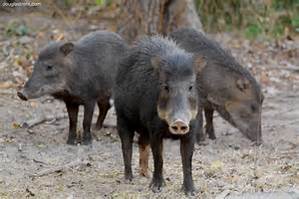Peccaries are wild pigs that live in herds of 20-200 individuals, with reports of up to 2,000 in a group. They range through central and south America, mostly in rainforests, but do extend into dryer forest and grassland habitats. A herd’s home range can include up to around 45 square miles while they search for seasonal nuts and fruits. Most of their diet is fruit and nuts but when these are difficult to find they will forage on leaves, stems, or animal parts. They live in habitats from sea level up to 6,200 ft. Tayassu – Latin for big tooth and pecari – Carib language pakira for peccary.
White lipped peccaries are 35 – 55 inches long and 15-24 inches tall and weigh 55 – 90 lbs. In the wild they live up to 13 years. They are black or brown with a bristly line of hairs running the length of their back, which stand up when they are excited. Their name comes from the white markings that start below their snout and continue to the cheek below the eyes.

Peccaries can breed all year, depending on the location, but typically have two peak breeding sessions. Females will bear one or two young during a season. The gestation period is about 160 days and the young are weaned within 6 months. They reach sexual maturity at 1.5 years. White-lipped peccaries are well adapted to cracking tough nuts they find on the forest floor, such as palm nuts.
Because of their long canine teeth that interlock, preventing sideways motion of the jaw, and their strong jaw muscles, they can break nuts not available to other animals. Similar nut-breaking animals, such as macaws, are called nut predators. Because they form large herds they must be nomadic in their search for food. These are the only neo-tropical animals that form large herds. They may travel in single file or in small, bunched groups. http://www.arkive.org/white-lipped-peccary/tayassu-pecari/video-00.html
Peccaries communicate with one another via acoustic, sensory, and olfactory methods. When traveling they constantly grunt and growl to one another, clatter their teeth, or when disturbed make a sharp bark. They regularly touch snouts with group members and they have a dorsal glad that produces a strong musk smell that is used in group grooming, thus helping to identify members. They are preyed upon by jaguar and cougar, and the occasional python. I was out birding with Connie and our guide Armando in the Bolivian Amazon when he paused and put up his hand for silence. In the distance I could hear this faint clicking sound. Armando looked around the jungle, back towards the noise and then the other way – and indicated we needed to walk off the trail a bit. After 40 yards or so he stopped and said “Esperamos” – we wait.
Slowly the clicking sound got louder and louder and a herd of about 50 white-lipped peccaries passed us while they were foraging for nuts. The sound of their teeth clicking plus the cracking of nuts was constant. After they passed I asked if they ever got feisty and attacked humans. Armando said if you were out alone hunting them, they would sometimes quickly gather into a line or semi-circle and then it was time for you to climb a tree. Armando then asked us which direction we thought leads back to the trail. Oh boy – looking around the jungle I hadn’t a clue and would have become peccary forage if left on my own.
The next day Miguel took us out for an early morning bird walk and we came across another heard of about 35 peccary. After we watched them for a bit, Miguel suddenly let out a loud yip-yip-yip call and all the peccaries formed a line, shoulder to shoulder about 30 yards from us – all staring at us.
I looked at Connie, then Miguel – should we be concerned? My random choice of a tree to climb could likely lead to some spiny/poisonous reaction so, help! Miguel then gave out another sharp yip-yip-yip and the peccaries quickly rumbled away in one direction and were gone.
Miguel just chuckled, shook his head, and said “Me encantan los cerdos” – I love the pigs.
